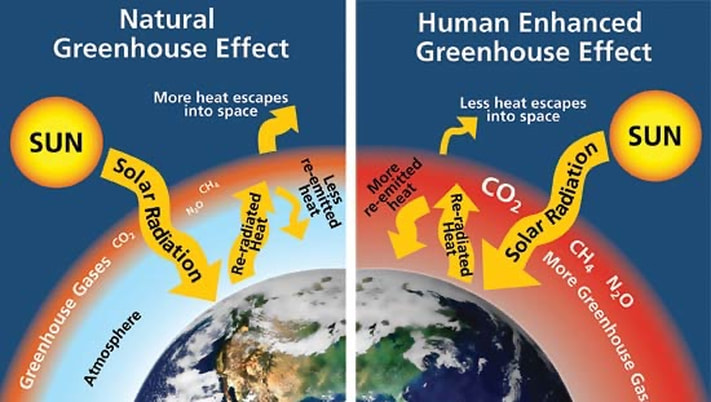What are Greenhouse gases & why do we measure them?
 Source: W. Elder, NPS, EPA Source: W. Elder, NPS, EPA
Greenhouse gases are gaseous molecules in our atmosphere which trap and hold infrared radiation, or heat. This is known as the greenhouse effect, and it is vital to life on this planet as we know it. Without greenhouse gases, most of the heat from the earth’s core and from the sun would escape into space, and Earth would be a much colder place (average temperature ~0 F). However, largely through the burning of fossil fuels, humans are pumping more of these gases into the atmosphere than any other time in Earth’s history. As a result, we have created a scenario where these increasing greenhouse gas concentrations in the atmosphere are trapping more heat that we want, causing the earth to warm and all the resultant consequences of global climate change.
Even if we stopped emitting greenhouse gases today, much of the CO2 we have already released would remain in the atmosphere for hundreds to thousands of years, allowing climate change to continue. Therefore, if we want to reverse or slow climate change, we also need to remove greenhouse gases from the atmosphere. As it happens, nature is excellent at removing CO2 from the atmosphere via photosynthesis. In particular, coastal blue carbon ecosystems are especially good at removing and sequestering CO2, therefore protecting and restoring these ecosystems could make a big dent in the most abundant fossil fuel-derived greenhouse gas already circulating in the atmosphere. 
The three most abundant greenhouse gases in the atmosphere as a result of human activities. Global warming potential shows the magnatude of a melecule's heat trapping potential relative to the same mass of CO2. Residence time refers to the amount of time a molecule of gas will remain in the atmosphere. Our sensors measure CO2 and CH4.
Data Source: EPA
However, it turns out that the consumption and production (also known as fluxes) of greenhouse gases in these systems are not as well studied as other components of the carbon cycle. Because the measurement of gas fluxes is costly and time consuming, we have insufficient data for many blue carbon ecosystems. This uncertainty means that blue carbon systems are often left out of global carbon models and budgets, despite their likely contribution.
This is why we have designed our sensors to measure carbon-based greenhouse gas, specifically CO2 and methane, fluxes in blue carbon ecosystems. By providing an affordable, ultra-portable means of quantifying greenhouse gas dynamics on our coasts, we hope to expand our understanding of these important ecosystems, highlight their value as nature-based climate solutions, and inform their management and protection for future generations. |
Summary |